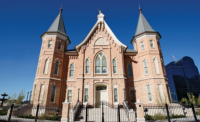The 21-mile-long Provo Reservoir Canal, which has delivered water from the Provo River to farms and residents of northern Utah County for a century, is finally getting a significant makeover.


When the $130-million project to replace the open channel with a buried 126-in. steel pipeline is complete, area residents who have lived with the benefits and the hazards of the canal will have a new walking and equestrian trail; water users will have a much-improved system; and endangered fish in the Provo River will have more water.
The channel, known locally as the Murdock Canal, snakes its way along the eastern bench of northern Utah County, just south of the Salt Lake Valley. It has been delivering water since 1911. But officials at the Provo River Water Users Association (PRWUA), which owns and operates the canal, realized that if the major water artery were to continue to serve the growing population of the region, changes would have to be made.
The unlined canal was losing up to 10% of its water through seepage and evaporation. And the likelihood of more accidents—22 people have drowned in the canal over its history—was expected to increase along with the development that was occurring adjacent to its banks.
Keith Denos, general manager of PRWUA, says plans to enclose the channel have been “on the drawing boards” for at least 12 years. And they likely would have stayed there if not for the coordinated efforts by a wide range of stakeholders, including the canal's owners, wildlife conservation groups and the residents of half a dozen cities and towns that border the corridor.
“In 1995 we did a master plan for capital improvements [the PRWUA also operates a reservoir and several other canals], and on that list, enclosing the canal was the most expensive and far reaching,” Denos says. “We said it was a nice idea for some day, and it was put on the shelf.”
The estimated price tag for the project was nearly $150 million.
Water Savings
But the possibility of saving water and keeping it in the Provo River system drew the attention of members of the Central Utah Water Conservancy District (CUWCD) and the Jordan Valley Water Conservancy District, which operate extensive water infrastructure systems both south and north of the PRWUA.
“In 1998 the Central Utah district came to us and proposed to pay half the project cost in return for rights to the water that would be saved,” Denos says.
Enclosing the canal will save an estimated 8,000 acre-ft of water a year, the owner says. The savings will increase water in tributaries to the Provo River, which will support efforts under way to preserve some endangered fish species.
As plans neared completion, representatives from the seven cities that border the canal approached PRWUA to build a trail on top of the pipeline.
Steve Cain, facilities and land manager for the PRWUA, says providing public access to the canal right-of-way had been proposed in the past but rejected because of the liability. “People have been pushing for a trail almost for the entire existence of the canal, but we have been resistant because we didn't want to invite people where there is a water hazard like this,” Cain says. “As we looked at enclosing the canal, that possibility opened up.”




